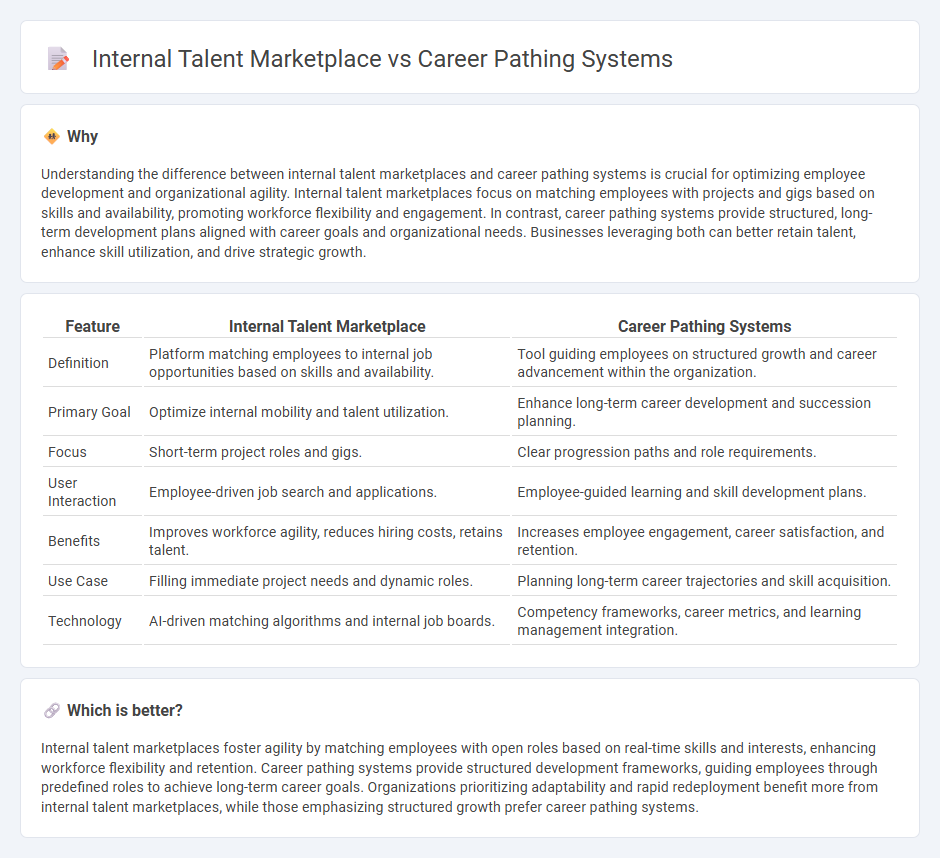
Internal talent marketplaces leverage real-time employee data and AI to match skills with company opportunities, enhancing workforce agility and optimizing talent utilization. Career pathing systems focus on structured development plans, guiding employees through predefined roles to foster growth and retention. Discover how these innovative HR tools can transform your organizational talent strategy.
Why it is important
Understanding the difference between internal talent marketplaces and career pathing systems is crucial for optimizing employee development and organizational agility. Internal talent marketplaces focus on matching employees with projects and gigs based on skills and availability, promoting workforce flexibility and engagement. In contrast, career pathing systems provide structured, long-term development plans aligned with career goals and organizational needs. Businesses leveraging both can better retain talent, enhance skill utilization, and drive strategic growth.
Comparison Table
| Feature | Internal Talent Marketplace | Career Pathing Systems |
|---|---|---|
| Definition | Platform matching employees to internal job opportunities based on skills and availability. | Tool guiding employees on structured growth and career advancement within the organization. |
| Primary Goal | Optimize internal mobility and talent utilization. | Enhance long-term career development and succession planning. |
| Focus | Short-term project roles and gigs. | Clear progression paths and role requirements. |
| User Interaction | Employee-driven job search and applications. | Employee-guided learning and skill development plans. |
| Benefits | Improves workforce agility, reduces hiring costs, retains talent. | Increases employee engagement, career satisfaction, and retention. |
| Use Case | Filling immediate project needs and dynamic roles. | Planning long-term career trajectories and skill acquisition. |
| Technology | AI-driven matching algorithms and internal job boards. | Competency frameworks, career metrics, and learning management integration. |
Which is better?
Internal talent marketplaces foster agility by matching employees with open roles based on real-time skills and interests, enhancing workforce flexibility and retention. Career pathing systems provide structured development frameworks, guiding employees through predefined roles to achieve long-term career goals. Organizations prioritizing adaptability and rapid redeployment benefit more from internal talent marketplaces, while those emphasizing structured growth prefer career pathing systems.
Connection
Internal talent marketplaces leverage career pathing systems to identify employee skills and match them with available opportunities, enhancing talent mobility within organizations. These platforms utilize real-time data analytics to optimize workforce planning and support personalized career development. As a result, companies experience increased employee engagement and retention by aligning individual goals with organizational needs.
Key Terms
Career Pathing Systems:
Career Pathing Systems provide structured frameworks enabling employees to visualize and plan their professional growth within an organization, aligning skills, roles, and competencies to future opportunities. These systems enhance employee engagement by offering clear development pathways and personalized learning plans, reducing turnover and boosting internal mobility. Explore how Career Pathing Systems can transform your workforce development strategy by fostering continuous growth and retention.
Skills Mapping
Career pathing systems utilize skills mapping to outline employee development trajectories by identifying current competencies and required skills for future roles, fostering targeted growth within an organization. Internal talent marketplaces emphasize dynamic skills mapping to match employees with real-time project opportunities and internal job openings, enhancing workforce agility and retention. Explore how integrating skills mapping in these platforms can optimize talent management and elevate workforce potential.
Succession Planning
Career pathing systems map employee growth trajectories within an organization, emphasizing skill development and role progression to align with long-term succession planning. Internal talent marketplaces facilitate real-time matching of employees to project opportunities and roles, enhancing agility in identifying successors by leveraging existing workforce capabilities. Explore how integrating these platforms can optimize your succession planning strategy for dynamic talent management.
 dowidth.com
dowidth.com